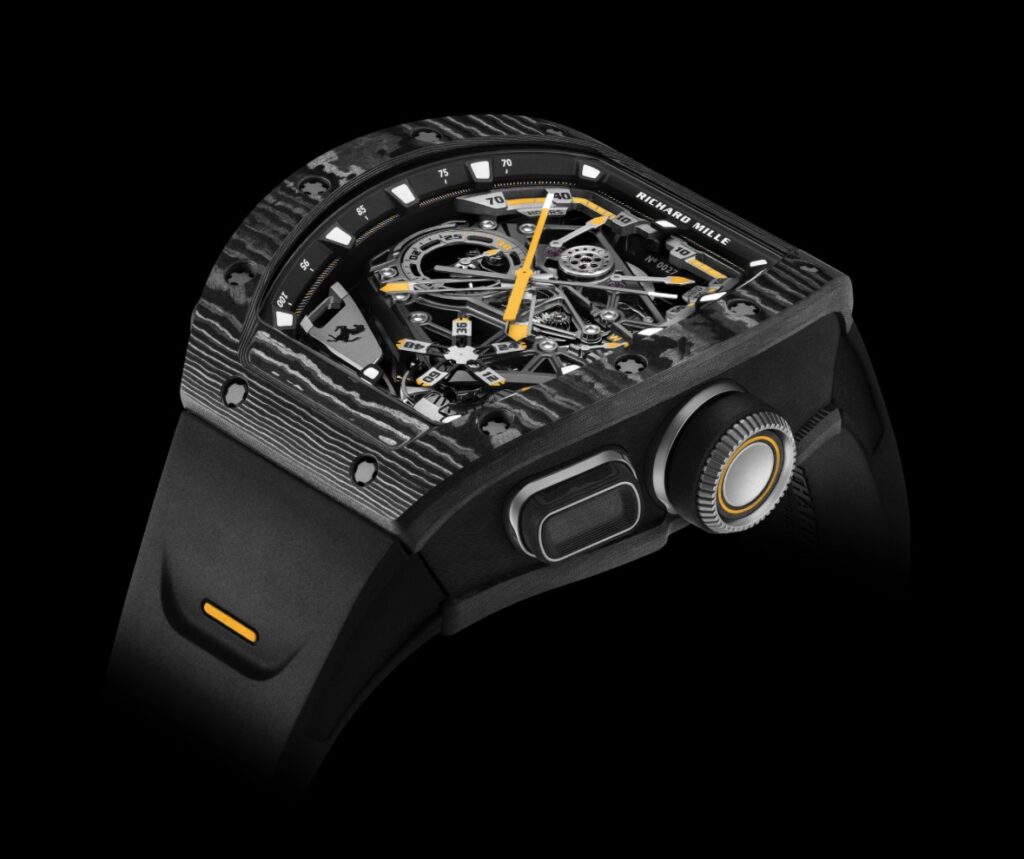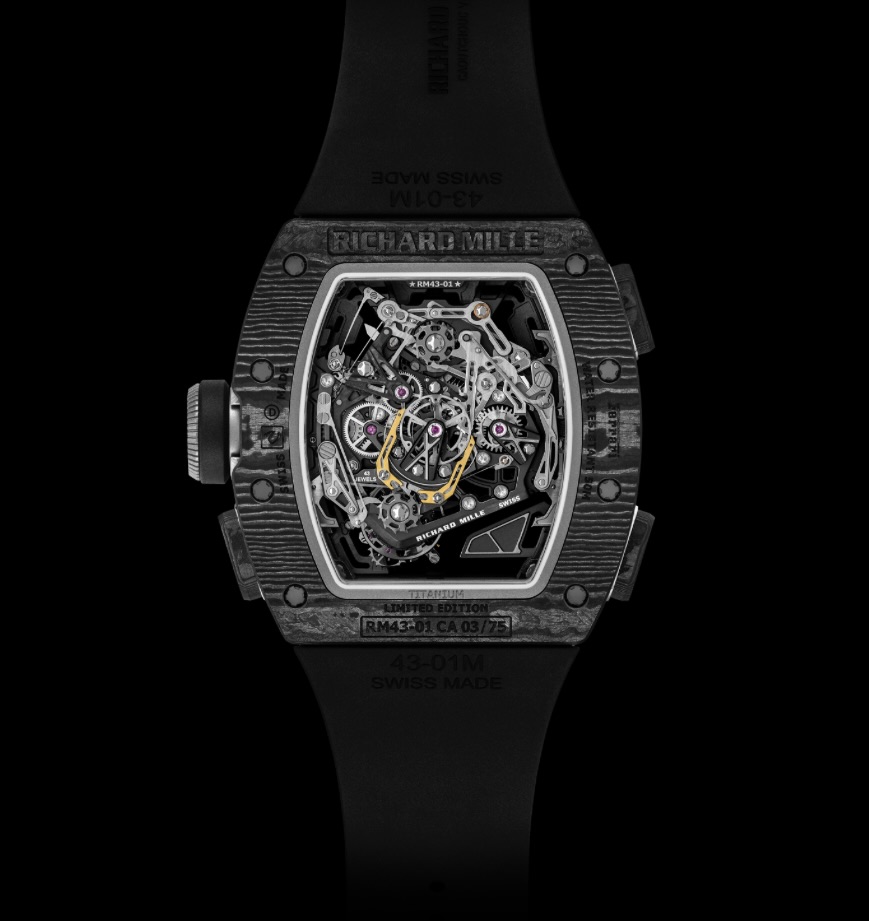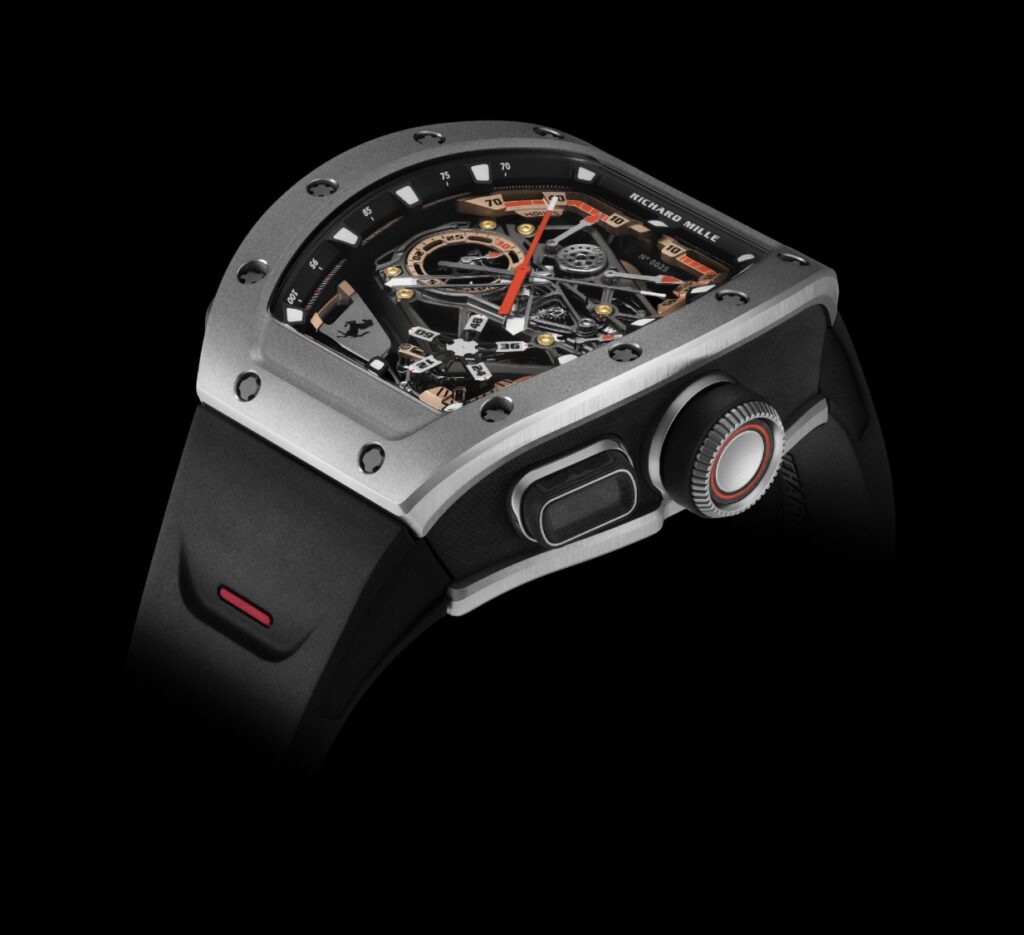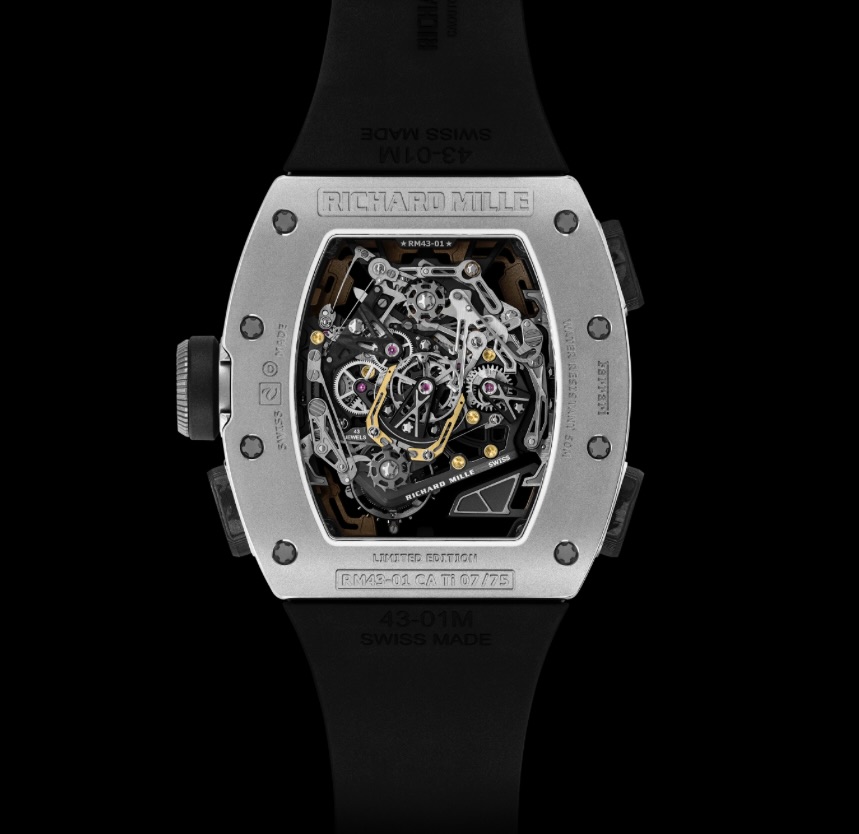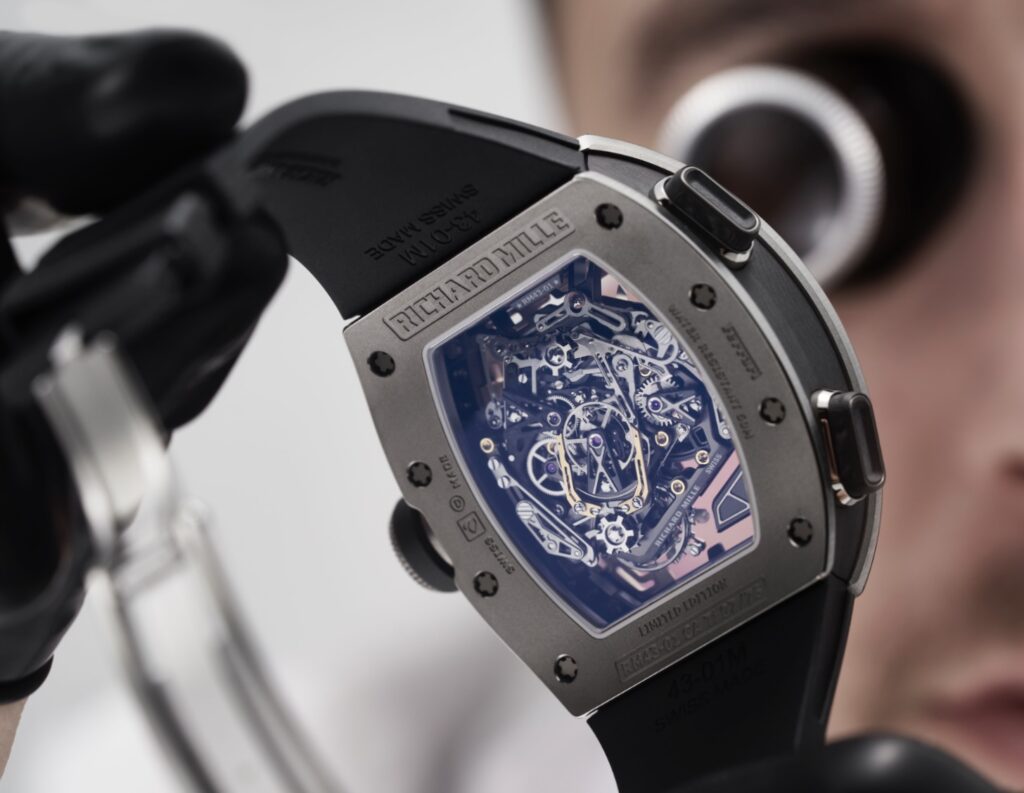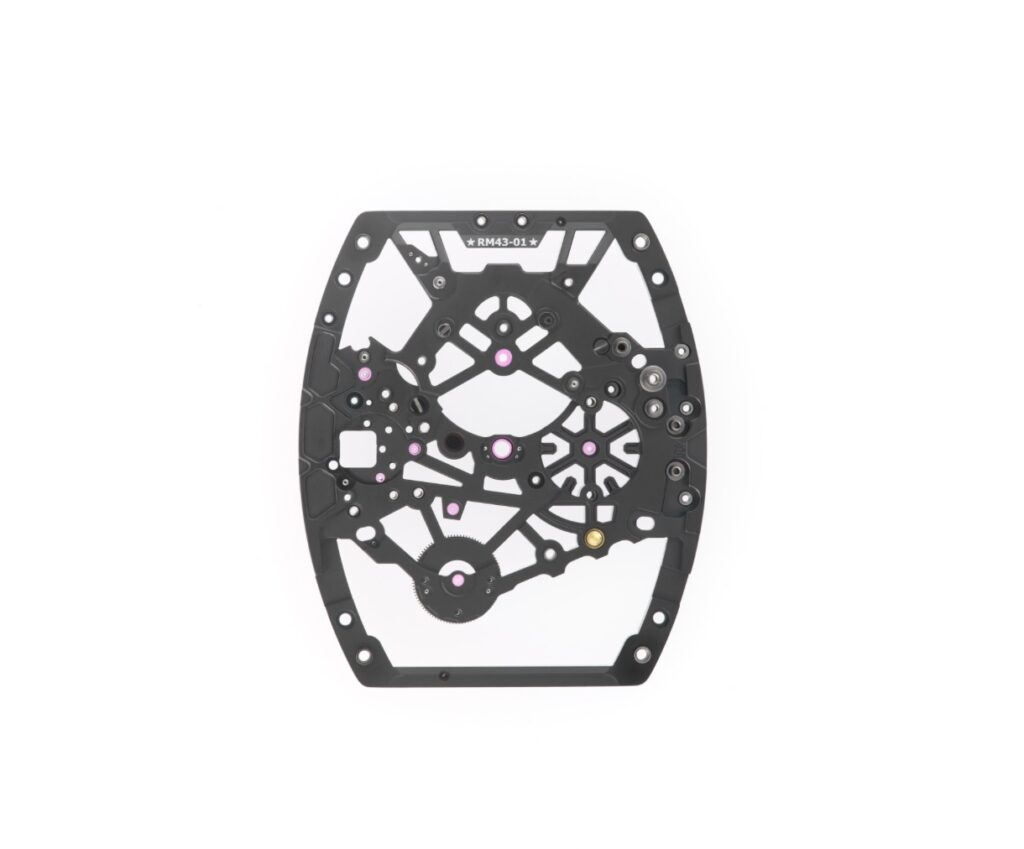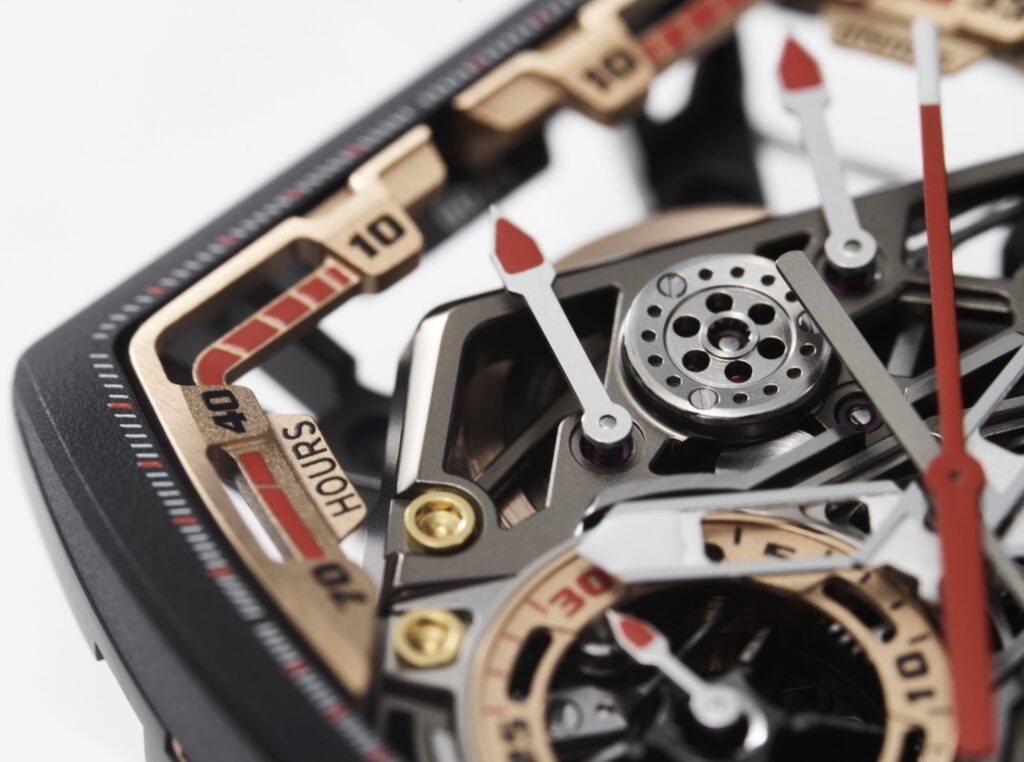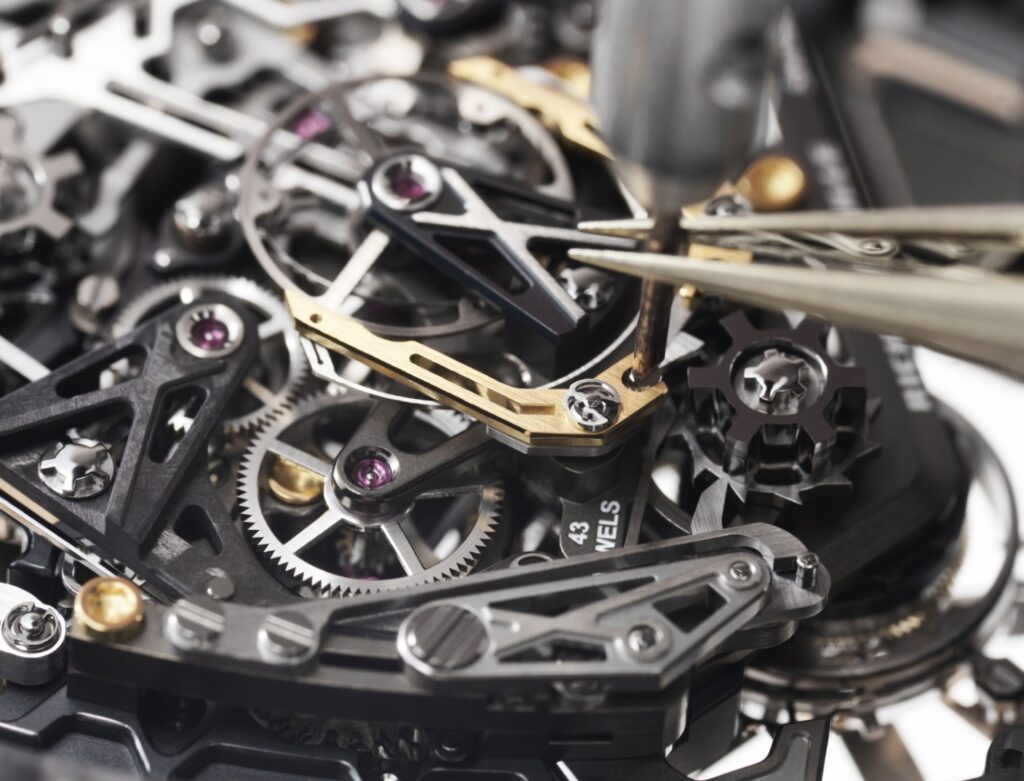Richard Mille and Ferrari have always spoken the same language—performance pushed to the edge, materials with a job to do, and aesthetics born from structural truth. With the RM 43-01 Tourbillon Split-Seconds Chronograph Ferrari, that dialogue turns into a full-throated duet: a kinetic object designed to time speed, shaped by speed, and—crucially—engineered to survive it. The result is a rattrapante tourbillon whose movement was developed from scratch over multiple years with Audemars Piguet Le Locle (APLL), housed in either Carbon TPT® or Grade 5 titanium—each version limited to 75 pieces—and animated by a ~70-hour power reserve (without the chronograph running). Prices land in rare air: $1,300,000 in titanium and $1,535,000 in Carbon TPT®.
ferrari, but make it horology
If the wafer-thin UP-01 Ferrari flow in 2022 showcased how far you could bend the idea of a watch in the direction of conceptual thinness, the RM 43-01 swings the pendulum toward mechanical theater: tourbillon, rattrapante chronograph, torque and function indicators, a 30-minute totalizer, and a new-generation split-seconds system designed for strength and reliability under shock. Where the UP-01 whispered, this one revs. The creative bridge to Maranello is explicit: Ferrari Chief Design Officer Flavio Manzoni worked closely with Richard Mille on the watch’s architecture and visual language, translating automotive cues—surface tension, intake-like apertures, even the tension of a crankcase—into the skeletonized horological frame.
the Movement: a purpose-built engine
Inside sits Calibre RM43-01, a manual-winding architecture built on a highly skeletonized grade 5 titanium baseplate, reinforced by bridges in titanium and Carbon TPT®. The rattrapante mechanism is the headline: this is Richard Mille’s latest-generation split-seconds—developed with APLL—which addresses the classic pain points of rattrapantes (fragility, drag, reset alignment) with robust kinematics, revised tolerances, and weight-optimized components. The total component count clears 500 parts (officially 514), yet the power reserve remains approximately 70 hours when the chronograph is idle—testimony to efficient energy management and friction reduction across the gear train.
Notable readouts on the dial side—power-reserve, torque, and function indicators—act like the car’s instrumentation cluster: you see available “fuel,” optimal mainspring torque for precision, and which crown mode (winding, neutral, setting) is engaged. A racy kinetic seconds display with rotating radial blades (think of a miniature cooling fan) adds a visceral, legibility-through-motion touch to the small-seconds concept, reinforcing the theme that every indication should feel alive when the watch is on the wrist.
chronograph as tool, rattrapante as tactic
A rattrapante (split-seconds) chronograph is not simply a stopwatch; it’s a strategy instrument. By layering a secondary seconds hand coaxial to the main chronograph hand and allowing it to stop independently while the primary keeps running, you can capture lap splits, intermediate times, or the delta between two cars that left the pit wall together. In motorsport terms, this is the difference between seeing motion and measuring race craft. The RM 43-01’s pusher feel—short travel, positive clicks—reflects the brand’s obsession with tactile fidelity. And because energy loss is the enemy of chronometric performance, the rattrapante clamping system and heart-cam geometry are tuned to minimize parasitic drag when the split hand rejoins at speed. (That detail—how quickly and cleanly the hands recombine—separates a merely complicated chronograph from a competition-grade one.)
structure as style
Richard Mille’s “form follows forces” worldview is visible everywhere. The tonneau case is not simply curved; it’s sculpted to manage torsion, shock, and sealing across a three-part case construction, using spline screws and engineered gaskets that maintain compression under thermal variation. Carbon TPT®—a proprietary, layered carbon composite—provides high specific stiffness at low mass and delivers that instantly recognizable striated grain; Grade 5 titaniumbrings aerospace familiarity and a colder, technical sheen. Both versions are limited to 75 pieces apiece, sharpening collectibility to track-only exclusivity levels.
Design cues nod directly to Ferrari: bevels and scoops that read like air intakes, pushers with a paddle-shifter vibe, and surfaces with the tautness of a body panel under aerodynamic load. This isn’t about embossing a prancing horse and calling it a day; it’s about transferring design disciplines—how to remove weight without losing stiffness, how to turn cooling into character—into a watch that feels as if it could be bolted to a carbon monocoque.
ergonomics at 200 mph (and 70 bpm)
Despite the mechanical density, the watch is engineered for wearability: a surprisingly balanced weight distribution, curved caseback, and a strap system that keeps the head locked in place without overt tension. On the wrist of Lewis Hamilton during a Grand Prix press conference, the watch looked less like a jewel and more like a control surface—a piece of kit. That’s Richard Mille’s trick: take the impossible and make it daily drivable—assuming your daily includes a pit lane.
why a tourbillon here?
In the abstract, a tourbillon compensates for positional rate errors by averaging them across a rotating cage. In a watch meant to be thrashed in real-world dynamics, some might question whether a tourbillon is necessary. Richard Mille’s answer has always been yes, if the cage and its supports are engineered for shock resistance and the rest of the going train is specced to keep amplitude stable under intermittent loads (e.g., chronograph engagement). The RM 43-01’s tourbillon, offset within the architecture, is framed intentionally as an engine bay: visible, celebrated, and hardened.
price, rarity, and the collector equation
$1.3 million (titanium) and $1.535 million (Carbon TPT®). Numbers that stir debate on the nature of value—until you remember the audience. Richard Mille and Ferrari are both fluent in price-as-signal: materials research, micro-engineering, supplier ecosystems, and a refusal to detune the vision create a cost base that is unapologetically high. Secondary market listings already narrate the story—offers stretching from roughly $1.59 million to $2.44 million, depending on case, condition, and seller confidence. That spread is typical at the ultra-high end when supply is 150 watches total and demand is elastic to fame, grid position, and macro liquidity.
from maranello to les breuleux
Flavio Manzoni’s Ferrari design studio has long practiced a kind of structural romanticism—forms that tell you what the underlying forces are doing. That maps neatly to Richard Mille’s grammar, where bridges, baseplates, and case ribs are the primary aesthetic drivers. The RM 43-01 leverages that shared mindset in tangible ways:
-
Layered transparency. Skeletonization isn’t just visual; it’s pedagogical. You can read the power flow from barrel to escapement, as if scanning an exploded technical drawing that happens to tick.
-
Directional surfacing. Chamfers and radii catch the light like body lines moving from nose to diffuser; each bevel is a vector cue.
-
Interface semantics. Pushers and crown carry a driver-control logic—distinct shapes, clear travel, immediate feedback. The function selector is the mode dial for a precision instrument.
innovation you can feel
Some innovations are only visible on a timegrapher. Others you feel the first time you press a pusher. The revised rattrapante of the RM 43-01 sits in the latter camp: a redrawn clamp, re-profiled heart cams, and optimized tolerances combine for low-drag operation and clean re-synch even under full mainspring torque. Less drag equals more amplitude retained, which equals better real-world rate stability over a timing session. The bigger point: when you’re timing a car—or just a life that moves at car speed—you want the chronograph to behave like a predictable control, not a delicate art piece.
the cultural moment
We live in an age when performance is often virtualized: simulations, telemetry dashboards, AI pit strategy. The RM 43-01 is the counterpoint—analog Ferrari in watch form. Dials and blades move because levers and springs move. The spectacle is the mechanics, not a rendered animation. That’s partly why the piece resonates beyond strict watch nerdery and into car culture at large; it becomes a bridge object between two tribes that already share a worldview about pushing envelopes.
what it means for richard mille x ferrari
Collaborations can calcify into logo swaps by round two. This one didn’t. Instead, RM’s second Ferrari watch leans into functional identity: split-seconds as a racing tactic; tourbillon as a performance promise; indicators as a driver’s gauge cluster; materials as motorsport orthodoxy. It’s the time-speed union the headline promises, not a co-branded souvenir. The fact that Lewis Hamilton has been spotted wearing it only tightens the loop between pit lane and wrist
No comments yet.

